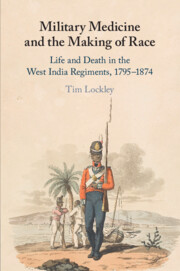Book contents
- Military Medicine and the Making of Race
- Military Medicine and the Making of Race
- Copyright page
- Dedication
- Contents
- Figures and Tables
- Acknowledgements
- Introduction
- 1 Medical Necessity and the Founding of the West India Regiments
- 2 The Ideal Soldier
- 3 The Use and Abuse of the Black Soldier
- 4 Statistics and the Reinterpretation of Black Bodies
- 5 Dehumanising the Black Soldier
- 6 Damage Done: The Asante Campaigns
- Conclusion
- Bibliography
- Index
5 - Dehumanising the Black Soldier
Published online by Cambridge University Press: 13 March 2020
- Military Medicine and the Making of Race
- Military Medicine and the Making of Race
- Copyright page
- Dedication
- Contents
- Figures and Tables
- Acknowledgements
- Introduction
- 1 Medical Necessity and the Founding of the West India Regiments
- 2 The Ideal Soldier
- 3 The Use and Abuse of the Black Soldier
- 4 Statistics and the Reinterpretation of Black Bodies
- 5 Dehumanising the Black Soldier
- 6 Damage Done: The Asante Campaigns
- Conclusion
- Bibliography
- Index
Summary
Chapter 5 shows just how influential Tulloch’s work was by analysing its effect on the American School of ethnologists. Debates about the origins of man, and specifically about the unity of the human species, had been ongoing since the middle of the eighteenth century, but crystallised in the 1840s and 1850s into a debate between monogenists and polygenists. In their attempt to prove that black and white people were fundamentally and innately different, the polygenists turned to the publications of British military surgeons and particularly to those of Alexander Tulloch. His work proved, they thought, that races could not become assimilated to different climates and that black people had been made for the African climate, not shaped by it. As a publication of the British army, American polygenists asserted that Tulloch’s work offered vital and impartial support for their claim that Africans and Caucasians were of different species.
- Type
- Chapter
- Information
- Military Medicine and the Making of RaceLife and Death in the West India Regiments, 1795–1874, pp. 139 - 163Publisher: Cambridge University PressPrint publication year: 2020

